
![]() The process of marking up my transcription has affected my understanding of the text. Throughout this process, I have read my text (Samuel Tippet) many different times in many different ways\forms. The original reading was reading it online through the original document which was a bit difficult to decipher. Next, I read while transcribing what the document had said. After this, I had to proofread what I had transcribed as well as my other group members to make sure it had made sense with no errors. This is when I read the whole story and it all came together. Next, with creating the timeline it pointed out the “landmark” events in Samuel Tippet’s life such as where he was born, marriage, and more. Tagging things such as a person, place, and emotion pointed out the most important people to my group members and I. It pointed out what people were mentioned the most, the most popular places as well as what emotions he was feeling throughout his memoir which were mostly negative unfortunately. He was a sad man that turned to God in order to help him throughout his life journey.
The process of marking up my transcription has affected my understanding of the text. Throughout this process, I have read my text (Samuel Tippet) many different times in many different ways\forms. The original reading was reading it online through the original document which was a bit difficult to decipher. Next, I read while transcribing what the document had said. After this, I had to proofread what I had transcribed as well as my other group members to make sure it had made sense with no errors. This is when I read the whole story and it all came together. Next, with creating the timeline it pointed out the “landmark” events in Samuel Tippet’s life such as where he was born, marriage, and more. Tagging things such as a person, place, and emotion pointed out the most important people to my group members and I. It pointed out what people were mentioned the most, the most popular places as well as what emotions he was feeling throughout his memoir which were mostly negative unfortunately. He was a sad man that turned to God in order to help him throughout his life journey.
Marking up my transcription has enhanced my understanding of the text because of rereading it several times. Each time, my group members and I had a different task such as creating a timeline, tagging, or actually publishing it. This means that we were noticing different things each time we were reading it. Most importantly, after every task, we proofread before submitting. I can confidently say I have a full understanding of my memoir after these steps.
Collaborating as an editorial board with my peers has changed my understanding of how edited texts are produced. Obviously, I knew that a lot of work had to be put in in order to produce a text. However, I did not realize how much work editors actually put in until experiencing it myself. My group and I did not even write this piece but marked it up and transcribed. Editing it was challenging because there were discrepancies over what some of the words were. We also had to make sure that names, places, and other important words were all capitalized, spelled the right way and had correct correlating tags before publishing. I now understand how important editing is to the publishing industry. It is also important to double check, reread and have another set of eyes when looking at a text. We resolved disputes over markup decisions by creating a google doc on certain words. For example, we decided to tag Jesus, Christ, and Jesus Christ. We decided not to tag Saviour or Lord. By creating rules, it helped us keep it standard throughout the text. I now commend all editors and give them a lot of props.
Along with this blog post, I uploaded two screenshots of the google doc I attached. One screenshot shows when\when not to capitalize Lord and Jesus. The other is a screenshot using a person’s name.
https://docs.google.com/document/d/15NewmsMvzz4pelwjiqQN9_ovH49tk1KW5Qk5dN5QiBo/edit
Morgan Graning is a junior at Bucknell University. She is a political science major and sociology minor. Morgan is from Long Island, New York.


